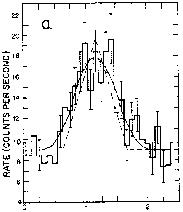


5.3. Diffuse Gas
As early as in 1956, the first detection of IC gas was claimed by Heeschen [66], based on 21-cm line-emission observations. Heeschen concluded that the total mass in HI was ~ 1/4 of the total cluster mass. However, his result was shown to be spurious by Muller [98].
Boldt et al. [17] first claimed detection of extended X-ray emission in the direction of Coma, but this finding was shown to be inconsistent with other observations (Friedman & Byram [48]).
In 1970 Turnrose & Rood
[142] used the
available H and X-ray data
to set an upper limit of 105 K to the temperature of a
diffuse gas with the
mass needed to bind the cluster. Their
work was published shortly before the real detection of
Coma in the X-ray by Meekins et al. and Gursky et al. (see
Fig. 10).
Assuming that the emission was thermal bremsstrahlung from an IC gas,
Gursky et al. estimated its mass in a few percent only
of the total cluster mass.
and X-ray data
to set an upper limit of 105 K to the temperature of a
diffuse gas with the
mass needed to bind the cluster. Their
work was published shortly before the real detection of
Coma in the X-ray by Meekins et al. and Gursky et al. (see
Fig. 10).
Assuming that the emission was thermal bremsstrahlung from an IC gas,
Gursky et al. estimated its mass in a few percent only
of the total cluster mass.
The detection of the Fe line with OSO-8 by Serlemitsos et al. [121], proved the thermal nature of the X-ray emission. At the same time, the presence of metals in the IC gas indicated that this had been at least partly processed in stars.
Currently, the contribution of the hot gas to the total mass is known to increase with the distance from the cluster centre, possibly up to ~ 50 % (Hughes). A cool diffuse gas component may have now been detected (Lieu, these proceedings).

|
Figure 10. The counting-rate distribution vs. the relative azimuth (in degrees) obtained with the Uhuru instrument in the direction of Coma; the solid line shows a fit to the data with an extended source model, while the dashed line shows the expected distribution for a point source - from Gursky et al. |